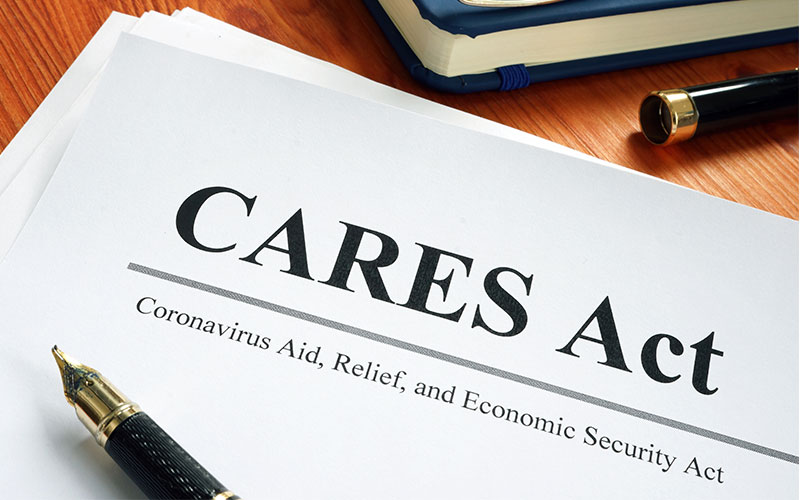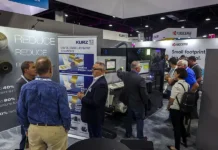By Michael J. Devereux II, CPA, CMP, Mueller Prost
On March 27, 2020, the Coronavirus Aid, Relief and Economic Security (CARES) Act – the largest relief package ever passed by Congress almost three times over – was signed into law, thereby ushering in a host of new lending and tax provisions available to print finishers.
The CARES Act made several taxpayer-favorable changes to the tax code that impact print finishers, some of which should provide much need cash during the COVID-19 pandemic. The following provides a brief overview of the business tax provisions of the CARES Act.
Employer retention credit
The CARES Act provides for a refundable payroll tax credit against 50% of the wages paid by eligible finishers to certain employees during the COVID-19 pandemic. The credit is available to finishers whose operations have been fully or partially suspended as a result of a government order or finishers who experienced a greater than 50% reduction of quarterly receipts, measured on a year-over-year basis.
The credit is equal to 50% of the qualified wages paid to employees from March 13, 2020, through December 31, 2020. The definition of qualified wages depends upon the number of average full-time employees in 2019. For finishers who had more than 100 average number of full-time employees in 2019, only the wages of employees who are paid during a shutdown or face reduced hours as a result of the plant’s closure or reduced gross receipts are qualified wages. However, for employers with 100 or less full-time employees in 2019, qualified wages also include amounts paid to all employees due to the reduced gross receipts.
Qualified wages include amounts paid or incurred to provide and maintain a group health plan (on a pro-rata basis) and are capped at $10,000, making the maximum amount of FICA payroll tax credit $5,000 per employee. Finishers receiving Small Business Interruption loans are not eligible for the Employer Retention Credit.
Employer FICA deferral
This provision of the CARES Act allows print finishers to defer payment of their employer share of the Social Security tax (FICA at 6.2%) for payroll tax deposits required to be made between March 27, 2020, and December 31, 2020. The amounts otherwise due during this period will be due in two installments – the first on December 31, 2021, with the remainder due on December 31, 2022.
Finishers receiving loan forgiveness through the Paycheck Protection Program, however, are not eligible for the deferral for amounts due after they receive notification of forgiveness.
Net operating and excess business losses
The CARES Act made two significant changes to the Net Operating Loss (NOL) rules and temporarily removed a limitation on business losses enacted by the Tax Cuts and Jobs Act of 2017 (TCJA).
First, the CARES Act removes the 80% of taxable income limitation that was enacted as part of the TCJA. Losses generated in any tax year beginning after December 31, 2017, and before January 1, 2021, (tax years 2018, 2019 and 2020 for calendar-year taxpayers) may offset 100% of the taxable income to which the loss is carried. The 80% of taxable income limitation is reinstated for tax year beginning after December 31, 2020.
Second, the CARES Act allows print finishers to carry their NOLs back to each of the five taxable years preceding any losses generated in tax years beginning after December 31, 2017, and before January 1, 2021, (2018, 2019 and 2020 calendar-year taxpayers).
The IRS issued special guidance for taxpayers who have already filed their 2018 or 2019 tax returns and would like to avail themselves of the modified rules for NOLs.
The CARES Act also delayed a provision originally enacted by the TCJA that limited “excess business losses for noncorporate taxpayers.” The TCJA had enacted a new limitation for owners of flow-through businesses (S Corporations, Partnerships or Sole Proprietorships). This provision, as enacted by the TCJA to be effective for tax years 2018 through 2025, limited business losses exceeding $250,000 ($500,000 in the case of married taxpayers filing a joint return) and were not eligible for carryback.
The CARES Act allows excess business losses for tax years 2018 through 2020 and, if net operating losses are generated, allow for a five-year carryback period.
Business owners should note, however, that the excess business loss limitation was just one way in which an owner’s loss could be limited. Taxpayers must still be at risk for and have sufficient basis to claim any ordinary loss. Further, passive shareholders may only offset passive income with passive losses.
Credit for prior year minimum tax (AMT credits)
The TCJA repealed the corporate alternative minimum tax (AMT). Taxpayers that had previously paid the AMT received Minimum Tax Credits (AMT Credits). The TCJA made those credits refundable over four years (2018 to 2021). The CARES Act accelerated the refundability of this credit, allowing the refundable amount in 2018, but making it fully refundable in tax year 2019. However, the CARES Act also provides for an election to take the entire refundable credit amount in tax year 2018.
Business interest limitation
The CARES Act temporarily increases the limitation on business interest expense for those subject to the limitation. The TCJA had introduced a new limitation for tax years beginning after December 31, 2017, whose average annual gross receipts exceeded $25 million, a limitation that is subject to inflations (the limitation applied to companies with average annual gross receipts of $25 million and $26 million in 2018 and 2019, respectively).
Any business interest expense that exceeds the sum of interest income and 30% of adjusted taxable income is not allowed as a deduction in the year paid or incurred, and the excess amount is carried forward as an interest expense to future tax years (indefinitely).
The CARES Act temporarily increases the limitation on the deductibility of net interest expense to 50% of adjusted taxable income for any tax years beginning in 2019 or 2020. Finishers concerned that their adjusted taxable income will be minimal or zero are allotted some relief in computing their 2020 adjusted taxable income limitation. At the election of the finisher, the 2020 interest expense limitation will be 50% of its 2019 adjusted taxable income.
Qualified improvement property
The TCJA modified both the bonus depreciation rules and the definition of qualified improvement property. The TCJA increased the bonus depreciation percentage to 100%, retroactively, for property placed in service after September 27, 2017, through December 31, 2022. Beginning in 2023, the bonus depreciation percentage is phased down by 20% each year, with the accelerated “bonus” depreciation phased out by 2027.
In addition, the TCJA consolidated three types of improvement category assets into a new category called Qualified Improvement Property (QIP). For finishers, QIP includes any improvements made to the interior of the facility that are placed in service after the date the facility was first placed in service. Improvements do not include enlargement of the building, elevators or internal structural framework.
In writing the TCJA, a general 15-year recovery period was intended to have been provided for QIP. However, due to a drafting error, that specific recovery period did not make it into the final statutory language of the bill. As such, under the TCJA, QIP fell into the 39-year recovery period for nonresidential real property, and, therefore, is ineligible for 100% bonus depreciation.
The CARES Act provided a technical correction to the TCJA and specifically identifies QIP as 15-year property for depreciation purposes. This also makes QIP eligible for 100% bonus depreciation. Given that it is a technical correction, the provision is retroactive, and finishers can write-off any QIP placed in service after December 31, 2017.
Concluding thoughts
Numerous other provisions, including the Paycheck Protection Program, the Economic Injury Disaster Loans and Emergency Grants, and individual tax relief, were enacted as part of the CARES Act, and Treasury seems to be issuing new guidance as quickly as issues or ambiguities arise. As it may be suspected, these provisions don’t exist within a vacuum. Many provisions impact others, as well as existing tax incentives. As such, careful planning is advisable.
Michael J. Devereux II, CPA, CMP, is a partner and director of Manufacturing, Distribution & Plastics Industry Services for Mueller Prost. Devereux’s primary focus is on tax incentives and succession planning for the manufacturing sector. He regularly speaks at manufacturing conferences around the country on tax issues facing the manufacturing sector. For more information, contact mdevereux@muellerprost.com.





